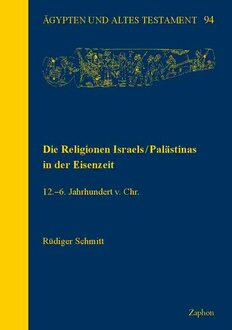
Die Religionen Israels / Palastinas in Der Eisenzeit: 12.-6. Jahrhundert V. Chr. (Agypten Und Altes Testament, 94) PDF
246 Pages·2020·6.858 MB·German
Most books are stored in the elastic cloud where traffic is expensive. For this reason, we have a limit on daily download.
Preview Die Religionen Israels / Palastinas in Der Eisenzeit: 12.-6. Jahrhundert V. Chr. (Agypten Und Altes Testament, 94)
Description:
Rudiger Schmitt offers an overview of the Iron Age religions of Israel / Palestine, i.e. Cis- and Transjordan, in their own contexts and historical developments. The late Canaanite religion (chap. 2), the Israelite-Judean religion (chap. 3), the religions of the Philistines (chap. 4), the Geshurites, Gileadites and the Aramaic-speaking entities in Palestine (chap. 5), the Ammonites (chap. 6), the Moabites (chap. 7) and the Edomites (chap. 8) are each contrasted in their own but identically structured chapters, so that differences, similarities and parallel developments emerge (chap. 9). The cultures of Israel/Palestine during the Iron Age are linked by a variety of historical, cultural and religious aspects. This applies above all to the structurally and closely related religious symbol systems and their family, local, regional and official subsystems as well as the strongly patriarchal social and value systems characterized by peasant and pastoralizing economic practices, which are particularly evident in the absolute dominance of male deities, in particular of the respective national god and in the family religion. Even if the respective religious symbol systems have local or national specifics, the religions of Palestine are materially and structurally a unity in diversity, just like the pantheon structures with their extensive personal overlaps below the level the national gods show. One can therefore legitimately speak of a Koine of the religious symbol systems of Palestine for the Iron Age.
See more
The list of books you might like
Most books are stored in the elastic cloud where traffic is expensive. For this reason, we have a limit on daily download.
